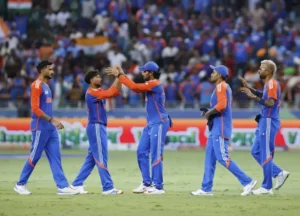Is Rashid Khan Losing His Magic in T20 Cricket?
Rashid Khan's struggles in IPL 2025 have raised concerns, as he has been far from his usual best. In three matches, he has conceded 102 runs in 8 overs at an economy of 12.75, taking just one wicket. His poor form was evident against RCB, where he leaked 54 runs in four overs. Rashid's impact as GT's x-factor has significantly diminished.

Being one of the most versatile players in T20 cricket and named the T20 Player of the Decade, Rashid Khan has long been regarded as one of the most valuable players in the format. Between 2018 and 2023, the Afghan leg-spinner was among the most economical bowlers, while also being a major wicket-taking threat. Playing for Sunrisers Hyderabad and Gujarat Titans during this period, Rashid claimed 122 wickets in just 95 matches, consistently dismissing key batters and maintaining a reputation as a game-changer.
However, in the last two IPL seasons, Rashid’s performances have not been as dominant. His ability to control the game in the middle overs has diminished, with batters increasingly choosing to play him cautiously and attack other bowlers instead. This shift in approach has impacted his wicket-taking ability, leading to a significant decline in his numbers, which has been visible in the IPL 2025.
Rashid Khan’s Performance in IPL 2025
In IPL 2025, Rashid’s struggles have been particularly evident. After three matches, he has managed just one wicket at a high average of 112, while his economy rate of 11.20 is the worst among Gujarat Titans’ bowlers. In contrast, left-arm spinner Sai Kishore has emerged as the team’s most effective bowler, leading their wicket charts with six scalps at an economy of 6.41. His disciplined lines and ability to generate dip, particularly with his carrom ball, have made him a standout performer.
This difference was highlighted in Gujarat Titans’ recent match against the Royal Challengers Bangalore. Kishore delivered an impressive spell of 4-0-22-2, dismissing Jitesh Sharma and Krunal Pandya, while Rashid endured a torrid outing, conceding 54 runs without picking up a wicket. His economy rate of 13.50 in the match further underlined his struggles. Moreover, in the history of the IPL, Rashid Khan has registered his second worst figures of the IPL history, and hence he hasn’t looked at his best for the Gujarat Titans team.
| Match Figures | Year | Name of the Opposition | Venue |
|---|---|---|---|
| 4-0-55-1 | 2018 | Punjab Kings | Mohali |
| 4-0-54-0 | 2023 | Kolkata Knight Riders | Kolkata |
| 4-0-54-0 | 2025 | Royal Challengers Bengaluru | Bengaluru |
| 4-0-51-0 | 2024 | Royal Challengers Bengaluru | Ahmedabad |
The signs of Rashid’s poor form were evident even before the RCB clash. In Gujarat’s game against Mumbai Indians, he was not trusted to complete his quota of overs—an extremely rare occurrence in his career. In the matches before and after that game, his figures have been disastrous, leaking 102 runs in eight overs at an economy of 12.75. This is a stark contrast to his usual reliability as a match-winner.
One of the most concerning aspects of Rashid’s performance has been his inability to capitalize on favorable situations. Against RCB, he came on to bowl when the opposition was struggling at 80/4, a situation that traditionally plays into the hands of an experienced leg-spinner. However, he failed to apply any pressure and instead allowed the batters to dominate him. Liam Livingstone, who had struggled massively against leg-spin in the last two IPL seasons and scored just 29 runs off 39 balls without hitting a single six, took Rashid apart. The English batter smashed 39 runs off just 17 balls, launching five sixes off Rashid’s bowling.
Adding to Rashid’s woes, his control over length and line has been uncharacteristically poor. Against RCB, nearly 30% of his deliveries were short, allowing batters to free their arms. Worse, he strayed down leg four times, conceding 15 runs off those misdirected balls.
With Gujarat Titans relying on their spinners to control the middle overs, Rashid’s lack of form has put additional pressure on the pacers.






Comments